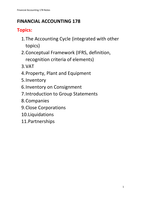Summary
Summary Financial Accounting 178 (whole year's work)
- Course
- Institution
Summaries of the whole year's Financial Accounting 178 work. Topics covered: -The Accounting Cycle -Conceptual Framework and IFRS -Property, plant, and equipment -Inventory -Inventory on Consignment -Introduction To Group Statements -Companies -Close Corporations -Liquidations -Partnerships. (This...
[Show more]



